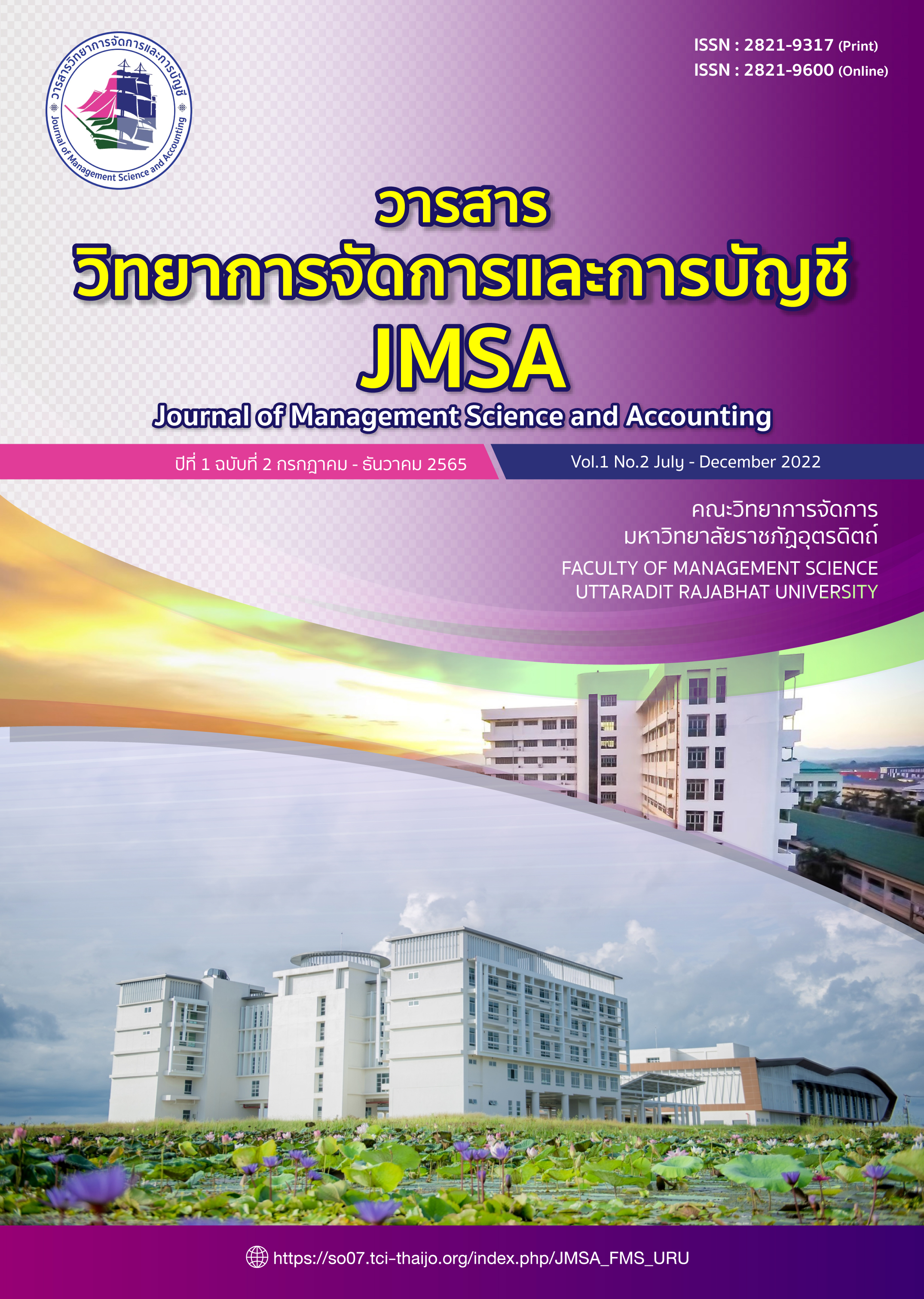Entrepreneurial Characteristics of Management Student, Management Science, Pibulsongkram Rajabhat University
Main Article Content
Abstract
The research aims 1) to study entrepreneurial characteristics of Management majoring students in Management Science at Pibulsongkram Rajabhat University, and 2) to compare entrepreneurial characteristics of Management majoring students in Management Science at Pibulsongkram Rajabhat university. The samples were 264 students studying in Management Science at Pibulsongkram Rajabhat University. The research tool was an online five Likert-scale questionnaire. The statistics employed include percentage, mean, standard deviation, t-test and ANOVA for data analysis.
The results of this research were as follows. 1) Management students had high entrepreneurial characteristics. 2) Gender and year of study had an impact on different entrepreneurial characteristics. The findings of the study can be applied to teaching and learning in Business Administration that focuses on creating business entrepreneurs into the labor market.
Article Details

This work is licensed under a Creative Commons Attribution-NonCommercial-NoDerivatives 4.0 International License.
Articles published in the Journal of Management Science and Accounting Uttaradit Rajabhat University It is the copyright of Uttaradit Rajabhat University.
Articles published in Journal of Management Science and Accounting Uttaradit Rajabhat University Considered to be the personal opinion of the writer. The editorial board does not have to agree. Authors are responsible for their own articles.
Authors who publish agree to the following terms:
- Authors retain copyright and grant the journal right of first publication with the work simultaneously licensed under a Attribution-NonCommercial-NoDerivatives 4.0 International (CC BY-NC-ND 4.0) that allows others to share the work with an acknowledgment of the work's authorship and initial publication in this journal.
- Authors are able to enter into separate, additional contractual arrangements for the non-exclusive distribution of the journal's published version of the work (e.g., post it to an institutional repository or publish it in a book), with an acknowledgment of its initial publication in this journal.
- Authors are permitted and encouraged to post their work online (e.g., in institutional repositories or on their website) prior to and during the submission process, as it can lead to productive exchanges, as well as earlier and greater citation of published work.
References
กระทรวงการอุดมศึกษา วิทยาศาสตร์ วิจัยและนวัตกรรม. (2565). History. https://www.mhesi.go.th/index.php/aboutus/history.html
ชัชวาลย์ เรืองประพันธ์. (2539). สถิติพื้นฐาน. โรงพิมพ์คลังนานาวิทยา.
ณัฐวุฒิ วิเศษ. (2552). คุณลักษณะและความตั้งใจที่จะเป็นผู้ประกอบการของนักศึกษาสาขาการเป็นผู้ประกอบการในกรุงเทพมหานคร. วิทยาลัยราชพฤกษ์.
มหาวิทยาลัยราชภัฏพิบูลสงคราม. (2565). ข่าวประกาศ. https://www.psru.ac.th/psru-group2/
Aaker, D.A., Kumar, V., & Day, G.S. (2001). Marketing Research (7th ed.). Wiley.
Awang, A., Amran, S., Nor, M. N. M., Ibrahim, I. I., and Razali, M. F. M. (2016). Individual Entrepreneurial Orientation Impact on Entrepreneurial Intention: Intervening effect of PBC and subjective norm. Journal of Entrepreneurship, Business and Economics. 4, 94–129.
Covin, J. G. and D. P. Slevin (1989). Strategic Management of Small Firms in Hostile and Benign Environments. Strategic Management Journal, 10(1), 75-87.
Greyman, V., Force, C.M. & Davis, L.M. (2015). Women in Business: Influences on the Undergraduate Major Choices. Administrative Issues Journal, 5(2), 51-63.
Haider, S. H., Asad, M., & Fatima, M. (2017). Entrepreneurial Orientation and Business Performance of Manufacturing Sector Small and Medium Scale Enterprises of Punjab Pakistan. European Business & Management, 3(2), 21–28.
Hall, R.E. & S.E. Woodward. (2010). The Burden of Non-Diversifiable Risk on Entrepreneurship. American Economic Review, 100(3), 1163-1194.
Hytti, U., Stenholm, P., Heinonen, J., & Seikkula-Leino, J. (2010). Perceived Learning Outcomes in Entrepreneurship Education: The Impact of Student Motivation and Team Behavior. Education+Training, 52(8/9), 587-606.
Louw, L., Du Plessis, A.P., Bosch, J.K. & Venter, D.J.L. (1997). Empirical Perspectives on the Entrepreneurial Traits of Undergraduate Students at the University of Port Elizabeth: An Exploratory Study. Management Dynamics, 6(4), 73-90.
Melati, I. S., Arief, S., & Baswara, S. Y. (2018). Does Financial Background Affect Entrepreneur Students’ Creativity: An Investigation of How Rich and Poor Students Start their Businesses. Journal of Entrepreneurship Education, 21(1), 1–11.
Miller, D. (1983). The Correlates of Entrepreneurship in Three Types of Firms. Management Science, 29(7), 770-791.
Nunnally, J.C. (1978). Psychometric Theory. McGraw-Hill Book.
Nunnally, J.C., & Bernstein, I.H. (1994). Psychometric theory (3rd ed.). McGraw-Hill.
Parker, S. K., Bindl, U. K., & Strauss, K. (2010). Making Things Happen: A Model of Proactive Motivation. Journal of Management, 36(4), 827-856.
Rahman, A., Civelek, M. & Kozubikova, L. (2016). Proactiveness, Competitive Aggressiveness and Autonomy: A Comparative Study from the Czech Republic. Journal of Economics and Economic Policy, 11(3), 631-650.
Rovinelli, R. J., & Hambleton, R. K. (1976). On the Use of Content Specialists in the Assessment of Criterion-referenced Test Item Validity. Annual Meeting of the American Educational Research Association, 1-37.
Sexton, D. L. & Bowman, N. (1985). The Entrepreneur: A Capable Executive and More. Journal of Business Venturing, 1(3), 129-140.
So, I. G., Ridwan, A., Simamora, B. H., and Aryanto, R. (2017). Confirming Entrepreneurial Orientation Dimensions and Linking It with Entrepreneurial Intention among Business Students in Indonesia. International Journal of Economics and Management Sciences. 11, 277–299.
Yamane, T. (1973). Statistic: An Introductory Analysis (3rd ed). Harper and Row.
Yang, J. H. (2020). A Study of Entrepreneurship Education on Entrepreneurial Orientation of Korean and Chinese University Students: Focused on Entrepreneurial Self-Efficacy as Mediator. Asia-Pacific Journal of Business Venturing and Entrepreneurship, 15(3), 233-242.
Zhai, Y.M., Sum, W.Q., Tsai, S.B., Wang, Z., Zhao, Y. & Chen Q. (2018). An Empirical Study on Entrepreneurial Orientation, Absorptive Capacity, and SMEs’ Innovation Performance: A Sustainable Perspective. Sustainability, 10(314), 1-14.


